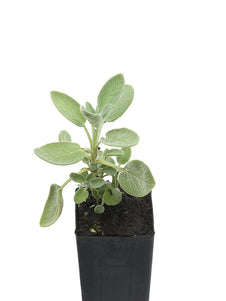





Salvia officinalis 'Berggarten'
Salvia officinalis 'Berggarten'

- In stock, ready to ship
- Inventory on the way

Usually available: All year
Life cycle: Perennial
Height: 60cm
Position: Full sun
Soil preference: Well drained
This is how we pack and send your Herb Plants to all states except TAS & WA
You will receive
- 1 Salvia officinalis 'Berggarten' Herb Plant in a 50 X 75mm tube - General growing instructions
All of our Herb Plants are grown organically with certified organic potting mixes and fertilizers
Botanical Name: Salvia officinalis 'Berggarten'
Salvia ‘Berggarten’ is an evergreen sub shrub, with a size of approximately 60cm by 60cm. It has woody stems and a compact mounding growth habit. The silver toned foliage is considered to be among the finest of all the grey foliage plants. The leaves are a stunning rich, grey-blue with the angle of the leaves creating constantly changing depth, texture and hues of silver, white, and deep grey. Sometimes the leaves appear quite green, while other plants are very silver toned. New leaves are usually bright green, but age to the soft downy grey colour. When grown in full sun the whole plant may take on a slight purple blush. The fragrant leaves reach up to 10 cm long, with an elliptical to ovate shape and veins visible as white lines. This sage rarely flowers, but when it does the blue-purple blooms are held on floral spikes in summer.
The name ‘Berggarten’ refers to ‘mountain garden’ and indicates the area in which this plant was grown on a German garden estate. This is an ornamental variety of culinary sage that was specially selected for its beauty. However, it performs very well as a culinary sage and is very flavourful and not bitter. It may be used in any recipe calling for sage and some say it tastes better than Common Garden Sage. Like the Common Sage, this variety has some potential health value and does well as a digestive aid.
Salvia ‘Berggarten’ is often short lived, but the fact that it rarely flowers extends its life. It prefers full sun and well drained soils. This plant is not fussy and the soil does not need to be high quality, but additional organic matter can be added. It is drought tolerant, with average water needs and a complete aversion to wet soil. To promote healthy new growth and keep the plant tidy, prune regularly by 10-12cm. Be careful not to venture into the woody growth or the plant may not recover and may be too exposed during winter. To propagate, cuttings may be used. It also does well in containers, which may help the plant survive over winter.
The salvia family has over 900 members with an extensive history as culinary, medicinal and ornamental plants. Ornamental salvias have become collectors items, as gardeners try to find a place in their garden for each and every one. There are salvias that will suit every type of soil and climate. More information on the Salvia genus and Common Sage (Salvia officinalis) may be found on our Common Sage page.
All information provided on this website is for informational purposes only. Please seek professional advice before commencing any treatment.






